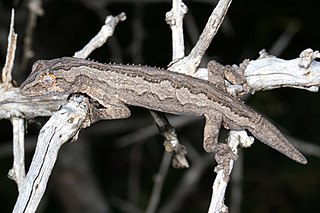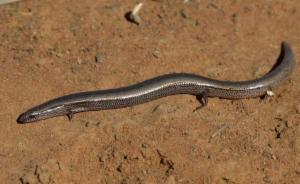
Cryptoblepharus is a genus of skinks, lizards in the family Scincidae. The genus contains at least 53 species.

Cryptoblepharus litoralis, the coastal snake-eyed skink or supralittoral shinning-skink, is a small skink found in North Queensland, Australia and New Guinea.

Cryptoblepharus virgatus, also commonly known as striped snake-eyed skink, cream-striped shinning-skink, wall skink, fence skink or snake-eyed skink is a skink commonly found in southern and eastern Australia. It is an active little lizard, and if threatened will often play dead to confuse the attacker.
Richard Sternfeld was a German-Jewish herpetologist, who was responsible for describing over forty species of amphibians and reptiles, particularly from Germany's African and Pacific colonies.

Ctenotus strauchii, also known commonly as the eastern barred wedge-snout ctenotus or Strauch's ctenotus, is a small species of lizard in the family Scincidae. The species is endemic to Australia and is found throughout semi-arid and arid regions in most of Australia's mainland states except Western Australia, although one record does exist for Western Australia in 1975.

Strophurus intermedius, also known commonly as the eastern spiny-tailed gecko or the southern spiny-tailed gecko, is a species of lizard in the family Diplodactylidae. The species is endemic to semi-arid regions of Australia in New South Wales, Northern Territory, South Australia, Victoria and Western Australia, in mallee shrubland and woodland habitats.

Diplodactylus conspicillatus, also known commonly as the variable fat-tailed gecko or the burrow-plug gecko, is a species of lizard in the family Diplodactylidae. The species is endemic to Australia, where it is found in central and arid inland areas. Widespread across the continent, the variable fat-tailed gecko is most commonly found in sandy desert habitats dominated by spinifex grasses. It has also been bred in captivity by zoos and as pets.

Oedura cincta, or inland marbled velvet gecko, is an Australian species of gecko.
Cryptoblepharus adamsi, also known commonly as Adams's snake-eyed skink, is a species of lizard in the family Scincidae. The species is endemic to Queensland in Australia.
Cryptoblepharus exochus, also known commonly as the noble snake-eyed skink, is a species of lizard in the family Scincidae. The species is endemic to the Northern Territory in Australia.
Cryptoblepharus gurrmul, also known commonly as the Arafura snake-eyed skink, is a species of lizard in the family Scincidae. The species is endemic to the Northern Territory in Australia.

Cryptoblepharus juno, commonly known as Juno's snake-eyed skink, is a species of lizard in the family Scincidae. The species is endemic to the Northern Territory, Australia.
Cryptoblepharus mertensi, also known commonly as Merten's snake-eyed skink, is a species of lizard in the family Scincidae. The species is endemic to the Northern Territory in Australia.
Cryptoblepharus pannosus, also known commonly as the ragged snake-eyed skink, is a species of lizard in the family Scincidae. The species is endemic to Australia.
Cryptoblepharus wulbu, also known commonly as the spangled snake-eyed skink, is a species of lizard in the family Scincidae. The species is endemic to the Northern Territory in Australia.

The saltbush Morethia skink, or more commonly referred to as saltbush skink, is a species of skink found in Australia. They are part of an 8 species genus of Morethia, which are all endemic to Australia. Akin to other members of the Morethia genus, saltbush skinks feature transparent disks as eye covers and eyelids which are stationary, along with specialised limbs which enable quick traversal of sand dunes. Taxonomically, the species was first classified by German explorer Wilhelm Karl Hartwig in 1871.
The ghost skink is a species of skink endemic to Australia.

The broad-banded sand-swimmer or Richardson's skink is a species of skink found in Australia.

Lerista timida, the dwarf three-toed slider or wood mulch-slider, is a species of skink found in Australia. Other common names for the species include timid slider and dwarf burrowing skink. The skink is a member of the Lerista genus which are confined to continental Australia and are mostly a burrowing species of skink. The genus consists of consists elongated, smooth-scaled, Fossorial lizards that are specialized for life in the upper soils and dry leaf litter through which they slide using Lateral undulation as a form of locomotive action, giving rise to their nickname as sliders. They normally emerge of a night-time to hunt for small Invertebrates such as ants, termites and insects. If disturbed, they dive immediately into any loose substrate to avoid predation, this behavior leaves behind a distinctive disrupted wavy track that often found on sandy flats or dunes, roads and tracks.

Brachyurophis australis(coral snake) is a species of snake from the family Elapidae (common names - eastern shovel-nosed snake, coral snake, Australian coral snake) and is a species endemic to Australia. Its common name reflects its shovel nose specialisation.













